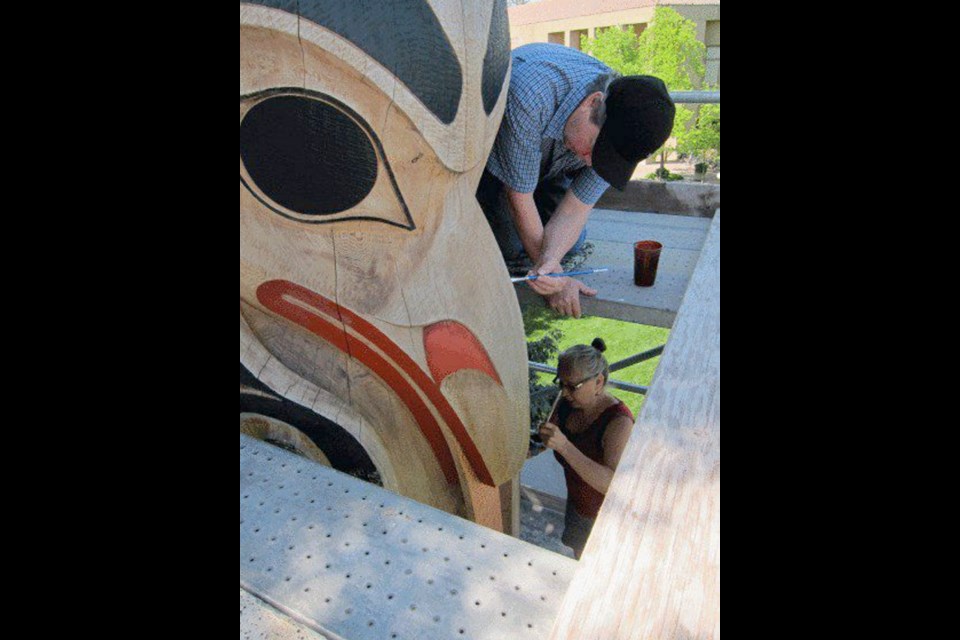The art world has lost a master carver, painter, teacher and mentor to young artists.
John Livingston died from cancer on March 9 at the age of 67.
On Thursday, his lifelong friend Pamela Madoff remembered Livingston as a modest and unpresuming man.
“It will be a challenge to write about him. I don’t think people will realize what we’ve lost,” said Madoff.
“Not only was John an extraordinary carver, but he was tireless in his support and mentoring of young artists.”
The former city councillor has photos of Livingston, working away behind the scenes.
“When Chief Tony Hunt’s totem was installed in the conference centre for its grand opening, John is in the background, lifting and organizing, anything that would assist with the installation,” she said.
Livingston was not Indigenous by birth. His mother, Dorothy, was instrumental in creating the Victoria Native Friendship Centre and this brought Livingston into contact with a large urban Aboriginal community.
Livingston became friends with Henry Hunt, whose father Mungo Martin was head carver for the Thunderbird Park carving program of the Royal B.C. Museum.
From 1971 to 1981, he and Calvin Hunt apprenticed with Tony Hunt Sr., carving totems at Thunderbird Park. Livingston learned the basics of design, tool techniques and hand skills. He worked on more than 25 large totems.
The two men kept in touch and worked together on large projects for the past 48 years. This year, they had three big jobs lined up, including a 60-foot totem in Port Alberni for the Truth and Reconciliation Commission, Hunt said Thursday, reached by phone at his Copper Maker Art Gallery in Port Hardy.
“His knowledge and skills were incredible. He’s truly going to be missed in the art world. Lots of young people looked to him for guidance because of his knowledge and his connection to the art world,” Hunt said.
Livingston was very good at replicating different styles — Tlingit, Bella Bella, Nisga’a.
“He could copy any style of Northwest Coast art,” Hunt said. “He and I replicated many Kwakwaka’wakw-style poles.”
Hunt said he is most proud of the totem pole they carved at Broadmead Lodge that honours Canada’s Indigenous war veterans.
“It’s one of our finest poles. We also carved a 25-foot feast dish for the Canadian Museum of History,” Hunt said.
In 2017, Hunt adopted Livingston into their family. “He was my brother. We grew up together.”
Thirty chiefs were present to witness the adoption, said Hunt. “There was lots of support for what we had done for him.”
Livingston’s wife, Maxine Matilpi, said he believed in giving back to the art world.
“Our ancestors passed it on from generation to generation and he believed in not being boastful about it,” she said.
“He was very humble about being an artist, When he was legally adopted into Calvin’s family, it just solidified John belonging to the Kwakwaka’wakw people. Our people always considered him to be one of us.”
Hunt’s nephew Mervyn Childs met Livingston in 1974 during a commercial fishing expedition with the Hunt family.
“John was really, really generous with his knowledge and confidence,” Childs said.
“They gifted him with knowledge and he was prepared to share it. One of his biggest contributions was sharing his knowledge with students and tutors.”
Livingston’s work is all over the Pacific Northwest, Childs said.
“His story’s big. It’s too big to quantify here. He influenced and taught lots of people. The cultural integrity was deeply embedded in who he was and who he would become.”
Livingston also worked as an appraiser and as a restorer.
In 2011, Livingston and Matilpi did restoration work on Victoria’s best-known totem in Beacon Hill Park. In 2013, they restored a pair of B.C. totems at Stanford University.
Livingston is survived by his 95-year-old father Edmund, Matilpi and five children from their blended family, Jason, Ann-Marie, Aubrey, Mandy and Carla, four grandchildren, sisters Mary, Ann, Jean and Ellen, brother Bill and his adopted family Calvin and Marie Hunt.



